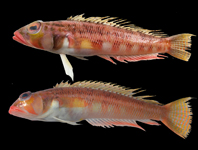Abstract
A new sandperch is described from 3 specimens from off Parangipettai, southeastern India. It can be separated from its congeners in having a combination of dorsal-fin rays V, 21‒22; anal-fin rays I, 17‒18; pectoral-fin rays 17‒18; pored lateral-line scales 53‒54; median predorsal scales 7; transverse scale rows 4/13; gill rakers on 1st gill arch 15‒17; single row of stout teeth on vomer; no teeth on palatine; 3 pairs of enlarged canines at front of lower jaw; opercle uniformly dark brownish; blade-like patch on cheek, the patch orange dorsally and reddish ventrally, fading entirely in preservative; dorsal fins light grayish with 2 rows of spots; a whitish longitudinal band just above lateral axis of body; dorsal surface of body with 8 irregular blackish saddles and lower half with 7 reddish bars and black dots on upper half of each bar; lower half of anal fin reddish; caudal fin grayish with upper and lower portion darker and vertical rows of orange dots on yellowish bands. The new species is most similar to Parapercis somaliensis and Parapercis kentingensis morphologically and genetically, but differs in coloration, serrations on the opercle, and body proportions. The establishment of the new species is also supported by DNA barcoding analysis.
References
Ho, H.-C. (2015) Description of a new species and redescriptions of two rare species of Parapercis (Perciformes: Pinguipedidae) from the tropical Pacific Ocean. Zootaxa, 3999 (2), 255–271.
https://doi.org/10.11646/zootaxa.3999.2.5
Ho, H.-C. & Shao, K.-T. (2010) Parapercis randalli, a new sandperch (Pisces: Pinguipedidae) from southern Taiwan. Zootaxa, 2690 (1), 59‒67.
https://doi.org/10.11646/zootaxa.2690.1.6
Ho, H.-C., Chang, C-.H. & Shao, K.-T. (2012) Two new sandperches (Perciformes: Pinguipedidae: Parapercis) from South China Sea, based on morphology and DNA barcoding. The Raffles Bulletin of Zoology, 60 (1), 163–172.
Johnson, J.W. & Motomura, H. (2017) Five new species of Parapercis (Perciformes: Pinguipedidae) from southeast Asia and northwest Australia. Zootaxa, 4320 (1), 121‒145.
https://doi.org/10.11646/zootaxa.4320.1.7
Kimura, M. (1980) A simple method for estimating evolutionary rate of base substitutions through comparative studies of nucleotide sequences. Journal of Molecular Evolution, 16, 111‒120.
https://doi.org/10.1007/BF01731581
Ogilby, J.D. (1910) On new or insufficiently described fishes. Proceedings of the Royal Society of Queensland, 23, 1‒55.
Randall, J.E. (2008) Six new sandperches of the genus Parapercis from the western Pacific, with description of a neotype for P. maculata (Bloch & Schneider). Raffles Bulletin of Zoology, Supplement 19, 159‒178.
Randall, J.E., Senou, H. & Yoshino, T. (2008) Three new pinguipedid fishes of the genus Parapercis from Japan. Bulletin of the National Museum of Nature and Science, Series A, Supplement 2, 69‒84.
Sambrook, J. & Russell, D. (2001) Molecular Cloning: A Laboratory Manual. 3rd Edition. Cold Spring Harbor Laboratory Press, Cold Spring Harbor, 2100 pp.
Schultz, L.P. (1968) Four new fishes of the genus Parapercis with notes on other species from the Indo-Pacific area (Family Mugiloididae). Proceedings of the United States National Museum, 124 (3636), 1‒16, pls. 1‒4.
https://doi.org/10.5479/si.00963801.124-3636.1
Shen, Y., Kang, J., Chen, W. & He, S. (2016) DNA barcoding for the identification of common economic aquatic products in Central China and its application for the supervision of the market trade. Food control, 61, 79‒91.
https://doi.org/10.1016/j.foodcont.2015.08.038
Tamura, K., Stecher, G., Peterson, D., Filipski, A. & Kumar, S. (2013) MEGA6: Molecular Evolutionary Genetics Analysis Version 6.0. Molecular Biology and Evolution, 30 (12), 2725–2729.
https://doi.org/10.1093/molbev/mst197


